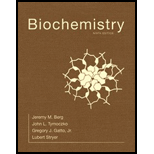
Concept explainers
Interpretation: The catalytic cofactors required by the pyruvate dehydrogenase complex are to be determined.
Concept Introduction:
Pyruvate dehydrogenase enzyme complex is required for the linking of glycolysis and TCA. It helps in the conversion of pyruvate into Acetyl CoA. Acetyl CoA then enters into the series of the citric acid cycle.
Answer to Problem 1P
Correct answer:
The correct answer is the option (a) NAD+, lipoic acid, thiamine pyrophosphate.
Explanation of Solution
Explanation/justification for the correct answer:
Option (a) NAD+ , lipoic acid, thiamine pyrophosphate. An irreversible catabolic reaction is catalyzed by the pyruvate dehydrogenase complex. It occurs at the entry point of pyruvate into the TCA cycle. It is a multifunctional enzyme complex. It catalyzes the oxidative decarboxylation of pyruvate to acetyl-CoA, CO2, and NADH.
It uses the NAD+, lipoic acid, thiamine pyrophosphate as cofactors. NADH and NAD+ are both forms of a coenzyme nicotinamide adenine dinucleotide. NAD+ get reduced by picking up the electrons lost in the oxidation and forms NADH. Pyruvate dehydrogenase uses the thiamine pyrophosphate or TPP as its prosthetic group. Lipoic acid acts as a cofactor for about five enzyme systems. Two of these enzymes systems are in the Krebs cycle. Hence, the option (a) is correct.
Explanation for incorrect answer:
Option (b) NAD+, biotin, thiamine pyrophosphate. Biotin is involved in some essential
Option (c) NAD+, FAD, lipoic acid. Lipoic acid acts as a cofactor for about five enzyme systems. Two of these enzymes systems are in the Krebs cycle. These help many organisms to produce energy. Hence, the option (c) is incorrect.
Option (d) FAD, lipoic acid, thiamine pyrophosphate. Lipoic acid acts as a cofactor for about five enzyme systems. Two of these enzymes systems are in the Krebs cycle. These help many organisms to produce energy. Hence, the option (d) is incorrect.
Thus, an irreversible catabolic reaction is catalyzed by the pyruvate dehydrogenase complex. It occurs at the entry point of pyruvate into the TCA cycle. It uses the NAD+, lipoic acid, thiamine pyrophosphate as cofactors. Hence, the option (a) is correct.
Want to see more full solutions like this?
Chapter 17 Solutions
Biochemistry (Looseleaf)
- Which features of the curves in Figure 30-2 indicates that the enzyme is not consumed in the overall reaction? ES is lower in energy that E + S and EP is lower in energy than E + P. What does this tell you about the stability of ES versus E + S and EP versus E + P.arrow_forwardLooking at the figure 30-5 what intermolecular forces are present between the substrate and the enzyme and the substrate and cofactors.arrow_forwardprovide short answers to the followings Urgent!arrow_forward
- Pyruvate is accepted into the TCA cycle by a “feeder” reaction using the pyruvatedehydrogenase complex, resulting in acetyl-CoA and CO2. Provide a full mechanismfor this reaction utilizing the TPP cofactor. Include the roles of all cofactors.arrow_forwardB- Vitamins are converted readily into important metabolic cofactors. Deficiency inany one of them has serious side effects. a. The disease beriberi results from a vitamin B 1 (Thiamine) deficiency and ischaracterized by cardiac and neurological symptoms. One key diagnostic forthis disease is an increased level of pyruvate and α-ketoglutarate in thebloodstream. How does this vitamin deficiency lead to increased serumlevels of these factors? b. What would you expect the effect on the TCA intermediates for a patientsuffering from vitamin B 5 deficiency? c. What would you expect the effect on the TCA intermediates for a patientsuffering from vitamin B 2 /B 3 deficiency?arrow_forwardDraw the Krebs Cycle and show the entry points for the amino acids Alanine,Glutamic Acid, Asparagine, and Valine into the Krebs Cycle - (Draw the Mechanism). How many rounds of Krebs will be required to waste all Carbons of Glutamic Acidas CO2?arrow_forward
- Sodium fluoroacetate (FCH 2CO2Na) is a very toxic molecule that is used as rodentpoison. It is converted enzymatically to fluoroacetyl-CoA and is utilized by citratesynthase to generate (2R,3S)-fluorocitrate. The release of this product is a potentinhibitor of the next enzyme in the TCA cycle. Show the mechanism for theproduction of fluorocitrate and explain how this molecule acts as a competitiveinhibitor. Predict the effect on the concentrations of TCA intermediates.arrow_forwardIndicate for the reactions below which type of enzyme and cofactor(s) (if any) wouldbe required to catalyze each reaction shown. 1) Fru-6-P + Ery-4-P <--> GAP + Sed-7-P2) Fru-6-P + Pi <--> Fru-1,6-BP + H2O3) GTP + ADP <--> GDP + ATP4) Sed-7-P + GAP <--> Rib-5-P + Xyl-5-P5) Oxaloacetate + GTP ---> PEP + GDP + CO 26) DHAP + Ery-4-P <--> Sed-1,7-BP + H 2O7) Pyruvate + ATP + HCO3- ---> Oxaloacetate + ADP + Piarrow_forwardTPP is also utilized in transketolase reactions in the PPP. Give a mechanism for theTPP-dependent reaction between Xylulose-5-phosphate and Ribose-5-Phosphate toyield Glyceraldehyde-3-phosphate and Sedoheptulose-7-Phosphate.arrow_forward
 BiochemistryBiochemistryISBN:9781305577206Author:Reginald H. Garrett, Charles M. GrishamPublisher:Cengage Learning
BiochemistryBiochemistryISBN:9781305577206Author:Reginald H. Garrett, Charles M. GrishamPublisher:Cengage Learning Biology: The Dynamic Science (MindTap Course List)BiologyISBN:9781305389892Author:Peter J. Russell, Paul E. Hertz, Beverly McMillanPublisher:Cengage Learning
Biology: The Dynamic Science (MindTap Course List)BiologyISBN:9781305389892Author:Peter J. Russell, Paul E. Hertz, Beverly McMillanPublisher:Cengage Learning Human Physiology: From Cells to Systems (MindTap ...BiologyISBN:9781285866932Author:Lauralee SherwoodPublisher:Cengage Learning
Human Physiology: From Cells to Systems (MindTap ...BiologyISBN:9781285866932Author:Lauralee SherwoodPublisher:Cengage Learning Biology 2eBiologyISBN:9781947172517Author:Matthew Douglas, Jung Choi, Mary Ann ClarkPublisher:OpenStax
Biology 2eBiologyISBN:9781947172517Author:Matthew Douglas, Jung Choi, Mary Ann ClarkPublisher:OpenStax Biology (MindTap Course List)BiologyISBN:9781337392938Author:Eldra Solomon, Charles Martin, Diana W. Martin, Linda R. BergPublisher:Cengage Learning
Biology (MindTap Course List)BiologyISBN:9781337392938Author:Eldra Solomon, Charles Martin, Diana W. Martin, Linda R. BergPublisher:Cengage Learning





